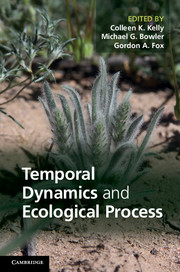Book contents
- Frontmatter
- Contents
- List of Contributors
- 1 Introduction
- Part I Observing temporal processes in nature
- 2 The storage effect: definition and tests in two plant communities
- 3 What temporal processes in trees tell us about competition, community structure and speciation
- 4 Testing the storage effect with long-term observational data
- 5 Seedling herbivory and the temporal niche
- 6 Temporal variation in density dependence in an herbaceous community
- 7 Population and community dynamics in variable environments: the desert annual system
- 8 Temporal niches, ecosystem function and climate change
- Part II Application to specific questions
- Index
- References
4 - Testing the storage effect with long-term observational data
Published online by Cambridge University Press: 18 December 2013
- Frontmatter
- Contents
- List of Contributors
- 1 Introduction
- Part I Observing temporal processes in nature
- 2 The storage effect: definition and tests in two plant communities
- 3 What temporal processes in trees tell us about competition, community structure and speciation
- 4 Testing the storage effect with long-term observational data
- 5 Seedling herbivory and the temporal niche
- 6 Temporal variation in density dependence in an herbaceous community
- 7 Population and community dynamics in variable environments: the desert annual system
- 8 Temporal niches, ecosystem function and climate change
- Part II Application to specific questions
- Index
- References
Summary
Introduction
Over 50 years ago, Hutchinson (1941) noted that variation in environmental conditions could alter the outcome of competition. One implication of his observation was that environmental fluctuations could promote coexistence, allowing many species to persist in a habitat where all but one would be excluded under constant conditions. By the end of the 1980s, Chesson and colleagues had clearly described the theoretical requirements for coexistence via the storage effect (Chesson and Warner 1981, Warner and Chesson 1985, Chesson and Huntly 1989). Yet despite the long history of these ideas, relatively few direct empirical tests of the storage effect exist. Studies from a variety of natural ecosystems provide partial evidence for the storage effect (Pake and Venable 1995, 1996, Kelly and Bowler 2002, Descamps-Julien and Gonzalez 2005, Facelli et al. 2005, Kelly et al. 2008), but tests of all the required conditions or quantification of the strength of the effect are much rarer (Cáceres 1997, Adler et al. 2006, 2009, Angert et al. 2009).
The lack of rigorous case studies limits our ability to generalise about the role of the temporal storage effect in maintaining diversity. We know that multiple coexistence mechanisms will operate in different communities, but currently we cannot say where the storage effect makes an especially important contribution. This information will be essential for understanding the consequences of expected increases in climate variability (Karl and Trenberth 2003, Jain et al. 2005, Salinger 2005, Allan and Soden 2008), which could impact species diversity in systems where the storage effect is important (Adler and Drake 2008). Understanding the influence of the storage effect on coexistence across a variety of ecosystems is therefore a prerequisite for anticipating future changes in species diversity.
- Type
- Chapter
- Information
- Temporal Dynamics and Ecological Process , pp. 82 - 101Publisher: Cambridge University PressPrint publication year: 2014
References
- 2
- Cited by



